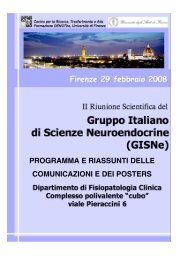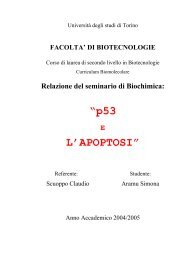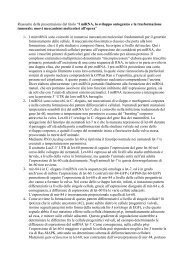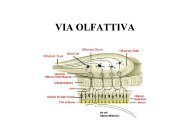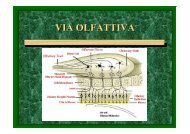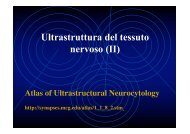GISNe - Anatomia, Farmacologia e Medicina Legale
GISNe - Anatomia, Farmacologia e Medicina Legale
GISNe - Anatomia, Farmacologia e Medicina Legale
Create successful ePaper yourself
Turn your PDF publications into a flip-book with our unique Google optimized e-Paper software.
RETINOIDS AND DOPAMINE RECEPTOR SUBTYPE 2 EXPRESSION IN HUMAN<br />
SECRETING AND NON SECRETING ADENOMAS<br />
Bondioni S., A.R.Angioni, G. Mantovani, M.Locatelli * , P. Rampini * , S. Ferrero § , E.Ferrante,<br />
P.Beck-Peccoz, A.Spada, A.G.Lania.<br />
Dept. of Medical Sciences, Endocrine-Metabolic Unit, University of Milan, Fondazione Ospedale<br />
Maggiore IRCCS Milano, *Dept.of Neurosurgery, Fondazione Ospedale Maggiore IRCCS Milano;<br />
§ Pathology Unit, Dept of Medicine, Surgery and Dentistry, A. O. San Paolo, Milan.<br />
It has been demonstrated that dopamine receptor subtype 2 (DR2) promoter contains a functional<br />
retinoic acid response element possibly involved in the control of DR2 expression as demonstrated<br />
by the low DR2 protein levels in animal models lacking this regulatory domain. Aim of the study<br />
was to evaluate the effect of 9-cis-retinoic acid (RA) treatment on DR2 expression in 16 human<br />
secreting and non-secreting pituitary adenomas (9 NFPA, 5 GH-omas, 2 PRL-omas). In basal<br />
conditions, variable levels of D2R protein were detected by immunoblotting in most tumors,<br />
without significant differences between NFPA and GH-omas. Conversely, the signal was absent in<br />
the two PRL-omas investigated. Cell exposure to RA (100 nM) increased DR2 protein levels in 5/9<br />
NFPA and 3/5 GH-omas, while no modification were observed in PRL-omas. These data were<br />
further confirmed at the mRNA levels since in non-responder tumors, RA treatment did not affect<br />
DR2 mRNA levels. Immunohistochemistry showed a homogeneous pattern of retinoic acid receptor<br />
RXRα, RXRβ and RXRγ isoforms expression without any correlations with the induction of DR2,<br />
thus suggesting that the absent D2R induction by RA in individual tumors was not related to RA<br />
receptor deficiency. Finally, RA did not significantly modify in vitro GH release from 3 cultured<br />
GH-omas, while induced a 67% stimulation of PRL release from the prolactinoma. In conclusion,<br />
the study showed that D2R was induced by RA in a consistent number of pituitary tumors,<br />
suggesting the existence of interaction between RA and D2R in human pituitary cells. However, the<br />
main goal of the study, i.e. the induction of D2R expression in prolactinomas, the tumor type that<br />
recognizes loss of D2R as a major cause of unresponsiveness to medical therapy, was not achieved.






